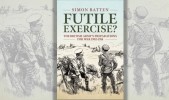Search
Using the filters to the left, click your selection, it will become bold and filter the results, click it again to remove that filter.
Major Kim Gilfillan graduated to AAAvn in 1997 and following the pilots course was posted to 161 Reconnaissance Squadron where he deployed to Timor Leste on a number of occasions. In 2003 he was posted to the Australian Defence Force Academy as a Divisional Officer and was subsequently selected for an exchange with the British Army in Germany in 2005. In 2006 he deployed to Iraq as the Commander of the British Army Air Corps Lynx (helicopter) Detachment. He recently completed his Master of Science and …
Major Steve Forrest is an officer in the Corps of Royal Australian Engineers. He is currently posted to Army Headquarters and is completing a Masters of Arts in Strategy and Management. … Steve Forrest …
Major Jim Hammett graduated from RMC in 1996 having served as a soldier and JNCO in 1 RAR between 1989 and 1994. He has served in a variety of regimental and instructional appointments, including 1 RAR, 2 RAR, RMC, School of Infantry and as an exchange Officer with 1st Bn Scots Guards. His operational service includes deployments to Somalia in 1993 (1 RAR), East Timor in 1999-2000 (2 RAR), Iraq 2004–2005 (Scots Guards), Timor Leste 2006 (1 RAR), Tonga 2006 (1 RAR) and Timor Leste 2007 (1 RAR). He is …
Colonel John Frewen is a career Infantryman who has served in 1 RAR, 2 RAR and the School of Infantry. In 2003, as CO 2 RAR, he led the initial regional military intervention force to re-establish law and order in Solomon Islands. Other operational service includes Rwanda and, in 2007, Afghanistan. In 2006 he was the Military Assistant to the Chief of Army. He has been posted with the armies of New Zealand and the United States and holds a Masters of Defence Studies from the University of NSW. Colonel …
Dr James H Willbanks is Director of the Department of Military History, US Army Command and General Staff College, Fort Leavenworth, Kansas. He is a Vietnam veteran and author of several books on the Vietnam War, to include The Tet Offensive: A Concise History (Columbia University Press, 2007), and Abandoning Vietnam (University Press of Kansas, 2004), a study of Richard Nixon’s Vietnamization policy and its aftermath. … James H …
Colonel Mark Mankowski is an Australian Army officer with nearly thirty years’ experience across a range of leadership, operations and training appointments within Australia and overseas. He is currently the Chief of Staff of the Land Capability Division at Army Headquarters. He holds a Bachelor of Science, majoring in Chemistry, from the Imperial College of Science, Technology and Medicine, a Master of Arts in Military History from the University of New South Wales and a Master of Military and Defence …
The British Army's Preparations for War 1902-1914 Helion , Warwick, 2018, 235pp Hardback ISBN: 9781911512851 Paperback ISBN: 9781804515686 Author : Simon Batten Reviewed By : Chris Roberts The subject of the British Army's reform and preparations prior to the Great War has received little serious study. Further, much of what has been written in general histories has been simplistic and derogatory based on shallow research, ill-founded assumptions or deliberate misinformation. Two notable exceptions …

LTCOL McLeod Wood (RAAC) is an Armoured Corps officer with experience across all three combat brigades, the 1st Australian Division Headquarters, and Headquarters Joint Operations Command. Since 2020, he has become focused on academic studies of mobilisation, publishing two theses and multiple smaller articles on the topic. He is a distinguished graduate of the United States Command and General Staff College ‘Art of War’ Program and the School of Advanced Military Studies. He holds four master’s degrees …
The Australian Army did not begin with the First AIF. On the contrary, the original force lived and died from March 1901 to December 1909. As responsibility for defence transferred from colonial to federal authorities, many problems of structure, administration and training came to the fore. The task of forging a these disparate structures into a national military organisation confronted a Federal Government already constrained by limited finances. This monograph shows how Australia's first army was …
